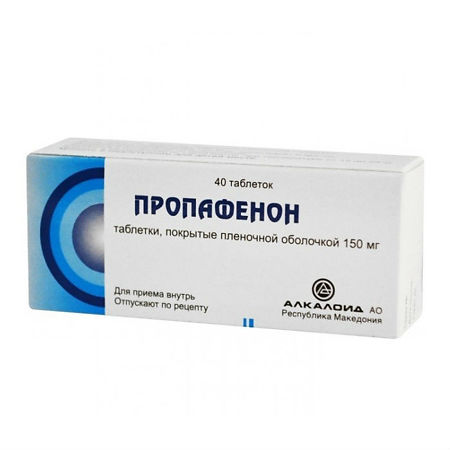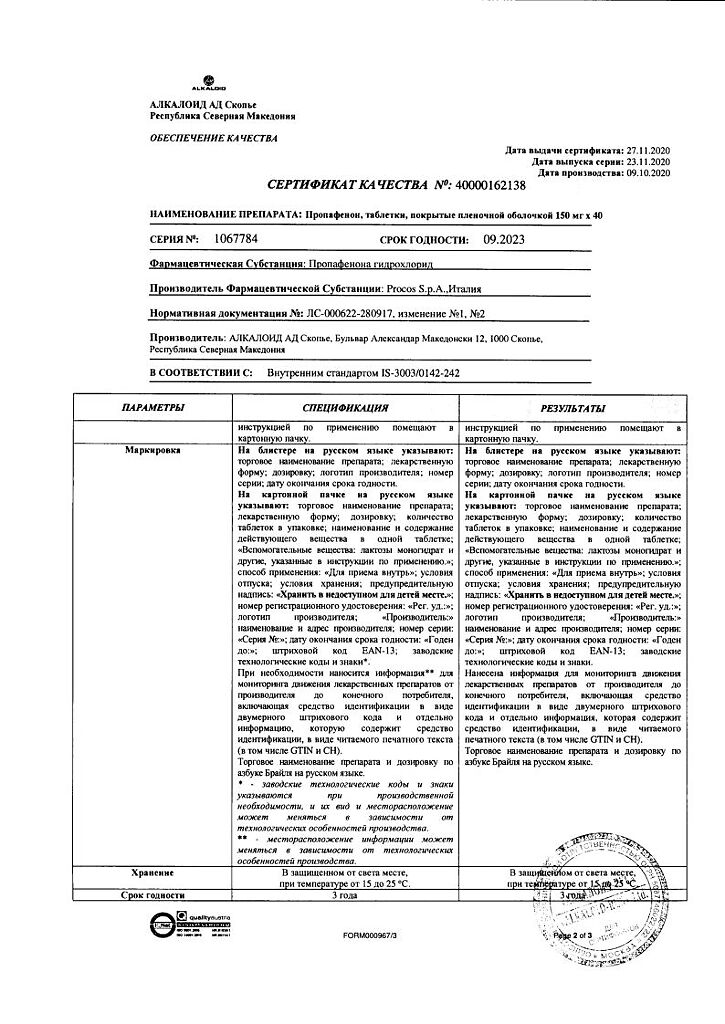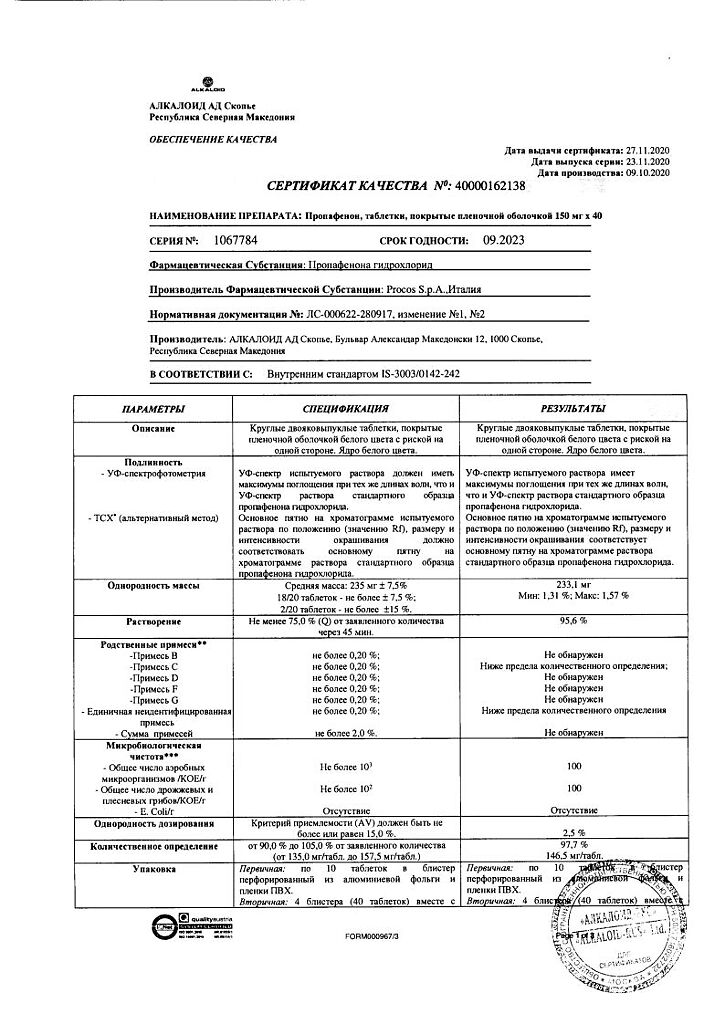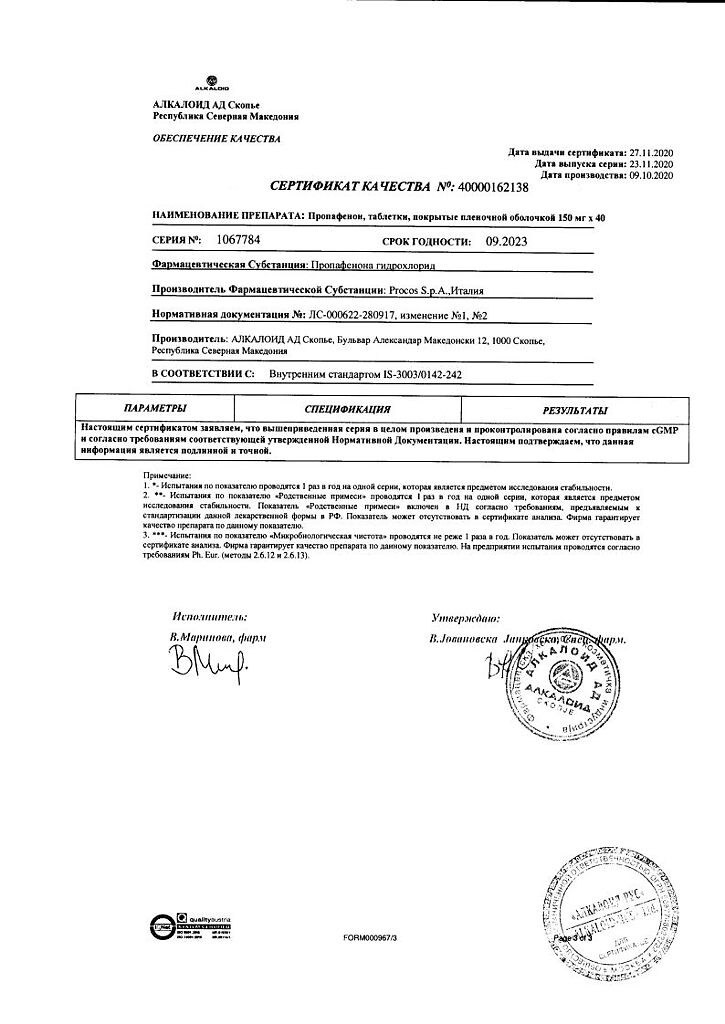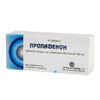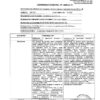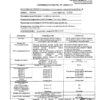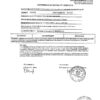No products in the cart.
Propafenone, 150 mg 40 pcs
€1.00
Out of stock
(E-mail when Stock is available)
Description
Propafenone is a class Ic antiarrhythmic drug, it blocks Na+ channels. It has a direct membrane stabilizing effect on myocardiocytes.
Decreases maximal speed of depolarization of phase 0 action potential and its amplitude in Purkinje and contractile fibers of ventricles, inhibits automatism. Slows conduction along Purkinje fibers. Lengthens conduction time along the SA node and atria. Does not affect or slightly increases the corrected recovery time of sinus node function during programmed electrical stimulation.
Lengthens the effective refractory period of the AV node, inhibits conduction through additional pathways in the retrograde and antegrade directions, increases the threshold for ventricular stimulation. Electrophysiological effects are more pronounced in ischemic than in normal myocardium.
It has weak beta-adrenoblocking (corresponding to about 1/40th of the activity of propranolol) and m-cholinoblocking effects. It has a negative inotropic effect, which is usually manifested when LV ejection fraction decreases below 40%.
It has local anesthetic activity corresponding approximately to the activity of procaine. Its action begins 1 hour after oral administration, peaks after 2-3 hours and lasts 8-12 hours.
Indications
Indications
Adrenal and ventricular extrasystoles, paroxysmal rhythm disorders, including atrial fibrillation and flutter, WPW syndrome, atrial-ventricular re-entry tachycardia (treatment and prevention); sustained monomorphic ventricular tachycardia (prevention).
Active ingredient
Active ingredient
Composition
Composition
Active substances:
Propafenone hydrochloride 150 mg
Auxiliary substances:
Cellulose microcrystalline 100.6 mg,
croscarmellose sodium – 14 mg,
hypromellose – 11.2 mg,
colloidal silica – 1.4 mg,
magnesium stearate – 2.8 mg.
Composition of the film coating:
film coating opadray II white: (polyvinyl alcohol 46.9%, macrogol 4000 – 23.6%, talc – 17.4%, titanium dioxide – 12.1%) – 10 mg.
How to take, the dosage
How to take, the dosage
Propafenone is taken orally after a meal (tablets should be swallowed whole with a small amount of water).
The dosing regimen is individual and adjusted by the physician: 150 mg every 8 hours (450 mg per day).
The dose is increased gradually, every 3-4 days, up to 600 mg per day in 2 doses or up to 900 mg per day in 3 doses.
Interaction
Interaction
Enhances plasma concentrations of propranolol, metoprolol, digoxin (increases the risk of glycoside intoxication), indirect anticoagulants, cyclosporine.
It enhances the effect of warfarin (blocks metabolism). Concomitant use with beta-adrenoblockers and tricyclic antidepressants may increase antiarrhythmic effect, with local anesthetics – increased risk of CNS damage.
Cimetidine and quinidine, slowing the metabolism, increase the plasma concentration of propafenone by 20%, rifampicin decreases it.
Amiodarone increases the risk of “pirouette” tachycardia. Drugs depressing SA and AV nodes and having negative inotropic action increase the risk of side effects.
The drugs that inhibit bone marrow hematopoiesis increase the risk of myelosuppression.
Special Instructions
Special Instructions
Treatment should be initiated in a hospital setting because of the increased risk of arrhythmogenic effects associated with propafenone use. It is recommended that prior antiarrhythmic therapy should be discontinued prior to propafenone treatment within a time frame equal to 2-5 T1/2 of these drugs.
The treatment should be carried out under control of electrolyte balance (especially K+ concentration) and ECG; periodically determine transaminase activity, antinuclear antibodies. Propafenone is more effective than class Ia and Ib antiarrhythmic drugs in the treatment of ventricular arrhythmias. In induced rhythm abnormalities, intracardiac electrophysiological examination is performed not earlier than 5-7 days after the start of administration.
In ventricular extrasystoles, the general rule is to reduce the number of extrasystoles by 70% of the baseline, according to daily Holter monitoring. During the treatment period it is necessary to be cautious when driving vehicles and performing other potentially dangerous activities requiring high concentration and quick psychomotor reactions.
Contraindications
Contraindications
Hypersensitivity, grade II-III AV block (without pacemaker), intraventricular bifascicular block (without pacemaker), cardiogenic shock, sinus bradycardia, CHF, CCSU, lactation.
Side effects
Side effects
Cardiovascular system disorders: bradycardia, AV dissociation, ventricular tachyarrhythmias, angina pectoris, worsening of heart failure course (in patients with reduced left ventricular function), SA and AV blockade, intraventricular conduction disorders, supraventricular tachyarrhythmias; when taken in high doses – orthostatic hypotension.
Digestive system disorders: change in taste, dry and bitter mouth, nausea, decreased appetite, feeling of heaviness in epigastrium, constipation or diarrhea; rarely – liver function disorders, cholestasis, cholestatic jaundice.
CNS disorders: headache, dizziness; rarely – blurred vision, diplopia, seizures.
Laboratory findings: leukopenia, thrombocytopenia, agranulocytosis, increased bleeding time, appearance of antinuclear antibodies.
Allergic reactions: skin rash, itching, exanthema, skin redness, urticaria, lupus-like syndrome.
Others: weakness, bronchospasm, hemorrhagic rashes on the skin.
Additional information
| Shelf life | 3 years |
|---|---|
| Conditions of storage | In a light-protected place at 15-25 °C |
| Manufacturer | Alkaloid AD Skopje, Republic of Northern Macedonia |
| Medication form | pills |
| Brand | Alkaloid AD Skopje |
Related products
Buy Propafenone, 150 mg 40 pcs with delivery to USA, UK, Europe and over 120 other countries.

